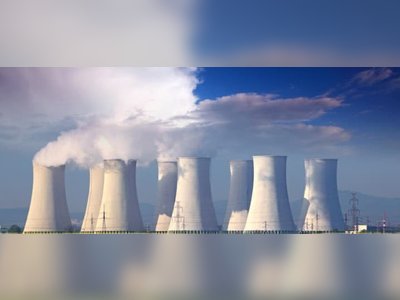
El Nino Likely To Return, May Fuel Spike In Global Temperatures: UN Agency
A warming El Nino event may develop in the coming months, according to a new update from the World Meteorological Organization (WMO).
A warming El Nino event may develop in the coming months, according to a new update from the World Meteorological Organization (WMO).
The El Nino event may develop after three consecutive years of an unusually stubborn and protracted La Nina, which influenced temperature and rainfall patterns in different parts of the world, WMO said in a statement.
However, while the return of El Nino is considered likely this will be proceeded by a period of El Nino-Southern Oscillation (ENSO) neutral conditions, with 90 per cent probability, during March-May, the statement said.
The likelihood of ENSO neutral conditions continuing beyond May decreases slightly but remains high, with 80 per cent likelihood in April-June and 60 per cent in May-July, based on the model predictions and assessment from experts involved in producing the Update, it said.
The chances of El Nino developing, while low in the first half of the year, 15 per cent in April-June, gradually increases to 35 per cent in May-July, the statement said.
Long-lead forecasts for June-August indicate a much higher chance, 55 per cent, of El Nino developing but are subject to high uncertainty associated with predictions this time of the year, the so-called spring predictability barrier, it said.
"The first triple-dip La Nina of the 21st century is finally coming to an end. La Nina's cooling effect put a temporary brake on rising global temperatures, even though the past eight year period was the warmest on record," said WMO Secretary-General Petteri Taalas.
"If we do now enter an El Nino phase, this is likely to fuel another spike in global temperatures," said Mr Taalas.
The year 2016 is currently the warmest on record because of the combination of El Nino and climate change.
There is a 93 percent likelihood of at least one year until 2026 being the warmest on record. There is also a 50:50 chance of the global temperature temporarily reaching 1.5 degrees Celsius above the pre-industrial era, according to a study last year by the UK's Met Office, which is WMO's lead centre for annual to decadal climate predictions.
The current La Nina began in September 2020 with a brief break in the boreal summer of 2021.
La Nina refers to the large-scale cooling of the ocean surface temperatures in the central and eastern equatorial Pacific Ocean, coupled with changes in the tropical atmospheric circulation.
It usually has the opposite impacts on weather and climate as El Nino in affected regions.
La Nina has been associated with the persistent drought in the Greater Horn of Africa and large parts of South America as well as above average rainfall in South East Asia and Australasia.
The El Nino and La Nina phenomenon occurs naturally. But it is taking place against a background of human-induced climate change, which is increasing global temperatures, affecting seasonal rainfall patterns, and making our weather more extreme.
El Nino and La Nina are major, but not the only, drivers of the Earth's climate system.
In addition to the long-established ENSO Update, WMO now also issues regular Global Seasonal Climate Updates (GSCU), which incorporate influences of the other major climate drivers such as the North Atlantic Oscillation, the Arctic Oscillation and the Indian Ocean Dipole.
A return to near-normal ENSO conditions is predicted for the equatorial central and eastern Pacific, and warmer-than-average sea-surface temperatures are generally predicted over other oceanic regions.
This contributes to widespread prediction of above-normal temperatures over land areas, according to the GSCU.
Even though La Nina is coming to an end we are likely to see latent impacts for some time to come and therefore some of the canonical rainfall impacts of La Nina may still continue.
The lingering impacts of multi-year La Nina is basically due to its long duration, and continuous circulation anomaly, which are different from the single-peak La Nina event.
The El Nino event may develop after three consecutive years of an unusually stubborn and protracted La Nina, which influenced temperature and rainfall patterns in different parts of the world, WMO said in a statement.
However, while the return of El Nino is considered likely this will be proceeded by a period of El Nino-Southern Oscillation (ENSO) neutral conditions, with 90 per cent probability, during March-May, the statement said.
The likelihood of ENSO neutral conditions continuing beyond May decreases slightly but remains high, with 80 per cent likelihood in April-June and 60 per cent in May-July, based on the model predictions and assessment from experts involved in producing the Update, it said.
The chances of El Nino developing, while low in the first half of the year, 15 per cent in April-June, gradually increases to 35 per cent in May-July, the statement said.
Long-lead forecasts for June-August indicate a much higher chance, 55 per cent, of El Nino developing but are subject to high uncertainty associated with predictions this time of the year, the so-called spring predictability barrier, it said.
"The first triple-dip La Nina of the 21st century is finally coming to an end. La Nina's cooling effect put a temporary brake on rising global temperatures, even though the past eight year period was the warmest on record," said WMO Secretary-General Petteri Taalas.
"If we do now enter an El Nino phase, this is likely to fuel another spike in global temperatures," said Mr Taalas.
The year 2016 is currently the warmest on record because of the combination of El Nino and climate change.
There is a 93 percent likelihood of at least one year until 2026 being the warmest on record. There is also a 50:50 chance of the global temperature temporarily reaching 1.5 degrees Celsius above the pre-industrial era, according to a study last year by the UK's Met Office, which is WMO's lead centre for annual to decadal climate predictions.
The current La Nina began in September 2020 with a brief break in the boreal summer of 2021.
La Nina refers to the large-scale cooling of the ocean surface temperatures in the central and eastern equatorial Pacific Ocean, coupled with changes in the tropical atmospheric circulation.
It usually has the opposite impacts on weather and climate as El Nino in affected regions.
La Nina has been associated with the persistent drought in the Greater Horn of Africa and large parts of South America as well as above average rainfall in South East Asia and Australasia.
The El Nino and La Nina phenomenon occurs naturally. But it is taking place against a background of human-induced climate change, which is increasing global temperatures, affecting seasonal rainfall patterns, and making our weather more extreme.
El Nino and La Nina are major, but not the only, drivers of the Earth's climate system.
In addition to the long-established ENSO Update, WMO now also issues regular Global Seasonal Climate Updates (GSCU), which incorporate influences of the other major climate drivers such as the North Atlantic Oscillation, the Arctic Oscillation and the Indian Ocean Dipole.
A return to near-normal ENSO conditions is predicted for the equatorial central and eastern Pacific, and warmer-than-average sea-surface temperatures are generally predicted over other oceanic regions.
This contributes to widespread prediction of above-normal temperatures over land areas, according to the GSCU.
Even though La Nina is coming to an end we are likely to see latent impacts for some time to come and therefore some of the canonical rainfall impacts of La Nina may still continue.
The lingering impacts of multi-year La Nina is basically due to its long duration, and continuous circulation anomaly, which are different from the single-peak La Nina event.










